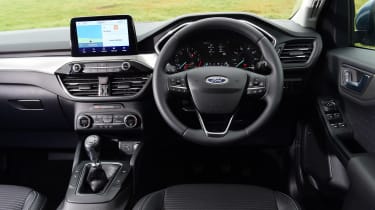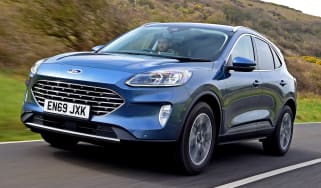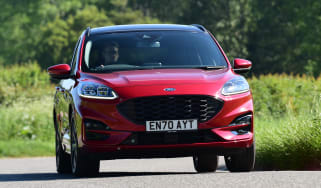Ford Kuga review: spacious and nimble hybrid family SUV
Practical and efficient, yet still great to drive, the Ford Kuga is an appealing family SUV

The third-generation Ford Kuga is easily the best iteration of family SUV the brand has produced so far. It blends great driving dynamics with useful on-board tech, good safety kit and plenty of practicality.
The Kuga doesn’t offer the plushest interior compared with its close rivals, but the overall package remains compelling. With efficient hybrid and plug-in hybrid models available and competitive prices across the range, the Kuga offers exceptional value for keen drivers who need a little more room for the family.
About the Ford Kuga
A quick look at the Ford Kuga family tree reveals that the first generation of this family-friendly SUV, launched in 2008, was little more than a high-riding Ford Focus. This was a good thing, though, and meant customers were treated to hatchback-style handling, while benefiting from the extra space and practicality of the larger five-door family car.
In 2012, Ford introduced the second generation of its mid-size SUV. Growing a little rounder in its middle age and, with increasing competition from the likes of the Peugeot 3008, Renault Austral and Kia Sportage, the Mk2 Kuga struggled to make its mark. Uninspiring looks, tired tech and the loss of its sharp driving dynamics did nothing to help its cause.
More reviews
Car group tests
In-depth reviews
Road tests
- Ford Kuga 2.5 Hybrid ST-Line X Edition 2021 review
- New Ford Kuga PHEV 2020 review
- Ford Kuga Titanium 2.0 EcoBlue 150 2020 review
Used car tests
Ford’s latest crack at the Kuga is just right. The manufacturer has concentrated on all the key areas, providing the Kuga with eye-catching good looks, decent levels of standard kit, an efficient range of engines, and solid safety credentials. It drives rather well, too.
The third-generation Kuga is based on Ford’s C2 platform, which shares its underpinnings with the Focus hatchback. Ride and handling are back to being standout attributes for the Kuga, and there’s more driving fun to be had compared to rivals such as the Toyota RAV4, Honda CR-V and Hyundai Tucson.
The VW group offers up the smart, but rather bland trio of the Tiguan, Skoda Karoq and SEAT Ateca. At the same time, there’s also the stylish Mazda CX-5 or the ever-popular Nissan Qashqai to consider.
A revision to the engine range in 2021 saw Ford remove diesel power altogether from the Kuga lineup. Engine choices now consist of a 1.5-litre EcoBoost petrol, a full-hybrid, and a 2.5-litre plug-in hybrid.
The 1.5 Ecoboost engine is paired solely with a six-speed manual transmission, while the hybrid and plug-in hybrid models use a CVT automatic gearbox.
Equipment levels start with the well-equipped Titanium Edition trim, followed by the sporty ST-Line Edition, ST-Line X Edition, before being rounded off by the more luxurious Black Package, Vignale, and Graphite Tech Edition. Entry-level kit includes 18-inch alloy wheels, LED headlights, front and rear parking sensors, a rear view camera, plus Ford’s SYNC 3 infotainment system with sat-nav. Top-spec versions add items such as bigger alloys, heated seats and a panoramic roof, while the sportier ST-Line editions come with firmer sports suspension. The Black Package and Graphite Tech Edition models have some unique exterior paint colours.
Used and nearly new
If you can afford it, then the third-generation Ford Kuga offers the most complete package as a family SUV. It's been on sale since 2020, so second-hand examples have had enough time to find their way onto dealer forecourts. Buyers may be able to land a Mk2 model for far less money, but will need to be prepared for the average load space and a cheap-feeling interior. First-generation cars, although older, were offered solely with the well-equipped Zetec and Titanium trim levels and are mostly available with diesel power – although there was a short-lived spell of 2.5-litre, five-cylinder petrol models using the same engine as the Ford Focus ST.
Ford Kuga history

Ford Kuga Mk2: 2012-2020
You won't find any efficient plug-in hybrid tech with a second-generation Ford Kuga, just straightforward petrol and diesel units. Compared to rivals such as the SEAT Ateca, the Mk2 Kuga was average to drive, with most models offering a front-wheel-drive set-up.
A variety of different trim levels were on offer, from entry Zetec through to Titanium, ST-Line and luxury Vignale versions, while a facelift in 2016 saw styling tweaks to the exterior, a redesigned dash, revised on-board tech and a new 119bhp diesel engine.

Ford Kuga Mk1: 2008-2012
The first-generation Kuga was relatively compact compared to the latest one, but its Ford Focus underpinnings meant it was one of the best-driving SUVs of its time. The practicality gains over the hatchback were minimal, though, and models fitted with the 2.5-litre petrol engine were thirsty.
Opting for diesel power meant more sensible running costs, but the purchase price of the Mk1 Kuga was quite steep. Build quality was solid, though, and it also boasted a five-star Euro NCAP safety rating.
For an alternative guide to the Ford Kuga, visit our sister site carbuyer.co.uk...

























